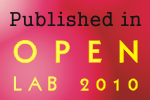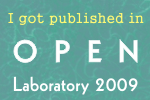On Lightning Talks
A lightning talk or a flash talk is a short presentation, typically anywhere between 1 and 5 minutes. They have been around for over 10 years in programmers’ meetings, and are slowly making inroads into scientific meetings.
The Good: lightning talks give more speakers a chance to present their material to an engaged audience; they cultivate succinct speaking skills. If you don’t like a talk in the session, you don’t have to wait for half an hour for the next one, you only have to wait for five minutes.
The Bad: a long session crammed with lightning talks may cause a jumble in the typical audience member’s brain. Talks that are early or late in the session may receive more attention due to the serial position effect, so that the middle talks are completely lost in the muddle, and the first and last couple of talks are those that are remembered.
Still, suppose you submitted an abstract to a conference, and made the cut for a lightning talk; what now?
Forget most of the skills you were taught for a regular 20 minute conference presentation, or 40 minute seminar. Lightning is a different beast. In a long talk, you teach a bit (background to the field & introduction to the problem at hand), show your stuff (your work), and advertise (show how your work contributed to the field, and how you left it better).
In a lightning talk, you want to get a single message across. And you want it to stand out. So you cannot afford to be too complex, you just don’t have the time.
Do: Prepare five to ten slides. Make sure they are sparse. An image or two per slide. No complex graphs. If you need words, write them big and few.
Do introduce yourself clearly at the beginning (name, affiliation, position, what you do)
Do clearly introduce whatever you are presenting.
Do give the acknowledgement slide at the beginning Although that is common practice in regular talk to give it at the end, in a lightning talk you want your last slide to be something else. See below.
Do speak at your normal pace.
Do make the last slide the impressive one: clear, strong message that will linger a minute longer during Q&A time, impressing itself upon the audience before it is time to move to the next talk. You do not want the acknowledgement slide to be last, as is traditionally done in longer talks.
Do: rehearse, rehearse, rehearse. Even if you are an accomplished speaker who can do a long talk without rehearsals, the lightning talk is a different beast. Waffling costs precious seconds, Moreover, getting back on track you may be tempted to speak faster to make up for lost time. Which is a no.
Don’t cram too many slides or be tempted to speak too fast. Find a way to convey your message at a normal speaking pace. Compressing more words into less time does not increase the information you convey, it actually deceases it. People can only process so much at a given time. Remember that a talk, including a lightning talk is about making people understand something new, not about you maximizing words-per-minute.
Don’t go over the allotted time. If you are not finished by the time the clock buzzes or the session chair signals you to get off, just say “sorry, time’s up. Catch me at the coffee break if you want to hear more.” — and step off the podium .
Ride the lightning!
Comments are closed.


















